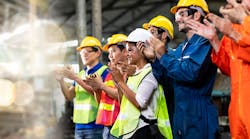Managing an industrial workforce is no easy feat. Enticing and training new recruits, retaining and developing existing staff, keeping everyone engaged and productive, and protecting them from all manner of environmental, health, and safety (EHS) issues are among the many challenges. Purpose-built software solutions, self-service technologies, flexible learning experiences, and modern collaboration tools all help to build a healthy workplace culture.
Hot tips for industrial electrical safety
Pandemic-inspired solutions
Times of crisis or uncertainty require unique recovery and resilience capabilities. New Wellbeing at Work solutions from UKG (Ultimate Kronos Group) provide plant managers with digital tools to quickly adapt so they can safely deploy frontline employees to meet production demand.
“With pre-shift wellness surveys, contactless time tracking using mobile or facial recognition technology, communication tools to keep employees informed of business updates or process changes, and scheduling and contact tracing capabilities, UKG Wellbeing at Work solutions enable manufacturers to not only communicate with transparency and build trust with their people, but also design and adapt flexible business strategies to ensure long-term success,” says Kylene Zenk, director of UKG’s manufacturing practice.
To help enterprises increase control over access to sites by temporary workers, contractors, and visitors, VelocityEHS recently extended the capabilities of its EHS and sustainability software suite with the acquisition of OneLook Systems. “COVID-19 has created urgency to improve control of work systems, including permit-to-work and contractor management,” explains Pat King, VP of VelocityEHS Europe.
“This urgency has driven plants to adopt self-serve, electronic control of work systems at an accelerated pace. Beyond that, though, more enterprises are including control of work in their digitalization initiatives because of the dual benefit it delivers in controlling real-time risks while also increasing visibility and safety awareness of on-site activity,” says King.
Connected worker advancements
Training and communication innovations are improving the efficiency, effectiveness, and safety of connected workers. For instance, the mixed-reality headset HoloLens 2 Industrial Edition from Microsoft is specifically designed to support regulated industrial environments such as areas where clean-room compatibility or intrinsic safety are required.
“In the semiconductor and pharmaceutical industries, partners require a device that meets particle emissions standards to enter and operate in their highly controlled clean room environments. In the energy sector, partners need a device that can function safely in potentially hazardous environments,” says Charlie Han, principal program manager for HoloLens at Microsoft.
A strategic learning partnership formed to help optimize remote worker safety and efficiency integrates AVEVA’s Unified Learning industrial training hub with OEG’s library of remote-learning content for basic process operator training.
With 3D cloud-based virtual training from AVEVA, people can train the same way they’ll be expected to work. “AVEVA XR for Training can interact with AVEVA Operator Training Simulators so that control room and field personnel can train in a cooperative, immersive experience,” observes Peter Richmond, portfolio director for Connected Worker and XR at AVEVA. “If the field operator opens a valve in virtual reality, the control room operator sees realistic changes in the process behavior.”
The Connected Worker solution from Anvl strives to detect and capture frontline worker insights at the earliest possible point. One of its newer features, In-App Messaging, enables real-time, two-way communication between managers and frontline workers.
Robin Fleming, CEO and co-founder of Anvl, suggests that it is essential for organization leaders to adopt connected worker technologies that frontline workers and supervisors will actually use. “The right tools, such as mobile applications, offer one place for smart procedures, real-time communication, and alerts that drive worker engagement, help organizations uncover issues and trends, and act more quickly on the information to drive continuous improvements,” she explains.
Communicating effectively in loud industrial environments is a challenge that got harder with social distancing. ListenTALK from Listen Technologies lets frontline teams communicate while maintaining a safe distance from each other on plant floors and in the field. A Duracell plant in Belgium chose the solution when face masks and minimum six-foot distances on the already noisy floor interfered with communications and safety.
“Supervisors and teams can hear clearly in large, noisy environments and communicate easily without having to shout,” says Tracy Bathurst, chief technology officer at Listen Technologies. “There is nothing to carry so individuals are free to perform their job duties. ListenTALK can also be used for training and VIP plant tours.”
This story originally appeared in the September 2021 issue of Plant Services. Subscribe to Plant Services here.
This article is part of our monthly Technology Toolbox column. Read more from Sheila Kennedy.


